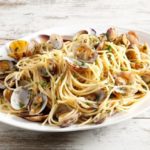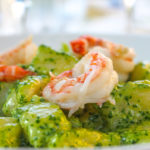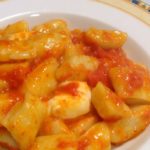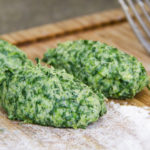CLAMS AND SUMMER, AN INSEPARABLE DUO.

When summer approaches, two things cannot be missed on an Italian table: spaghetti with fresh clams and a bottle of chilled dry wine
Usually, I love making fresh home-made pasta. However, sometimes stopping for a while, opening a bag of excellent durum wheat spaghetti, and making this simple and delicious pasta means it is summer – the holiday period for the most of Italians.
According to personal and regional preferences, there are a lot of variations in this dish: a pinch of chilli peppers, or 4-5 roughly chopped cherry tomatoes… This version is my favourite because nothing interferes with the taste of clams. To me, it is the symbol of Northern Adriatic – a small, enclosed sea and one of the richest for the production of seafood, particularly shellfish.
Spaghetti with fresh clams
- 1 lb. (400 gr.) spaghetti
- 2 cloves garlic, thinly sliced
- 3 tablespoons olive oil (extra virgin)
- 1/4 cup plus 2 tbsp chopped fresh Italian parsley
- 2 lbs. fresh clums, purged*
- 6 teaspoons marine salt
- *How to purge clams:Purging the clams is a simple but time-consuming process: first, pour fresh water in a bowl with a tablespoon salt, and lay a strainer in it. Move the clams in it, discarding the ones with cracked shells. Leave them sit for 20 minutes. Take the strainer off the bowl. You will find sand on the bottom of the bowl, discard the water and rinse the bowl, then pour more cold water in the bowl, a tablespoon salt and the strainer with the clams back in water. Repeat this operation four times more for a total amount of 2 hours.
- Heat the clams in a heavy large skillet over medium-high heat, covered with its lid, until clams pop open.
- Check them one by one as you move them to a bowl, discarding the ones which did not open (it means that they were not fresh).
- Filter half of the water produced by the clams pouring it through a white cotton napkin laid inside a fine mesh sieve. Since the quantity of water is a very limited one, also replacing the napkin with cheesecloth or a coffee filter is not a very lengthy process.
- Rinse the skillet and heat oil in it.
- Add sliced garlic and sauté until light brown, about 1 minute. Add 1/4 cup chopped Italian parsley; stir 2 minutes. Add clams and their juice. Cover and simmer about a couple of minutes.
- Meanwhile, cook pasta in large pot of boiling salted water until just tender but still firm to bite. Drain. Add pasta to clams and toss to coat. Usually there is no need to season to with salt, just add pepper.
- Sprinkle with remaining 2 tablespoons parsley and serve.







